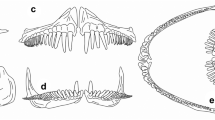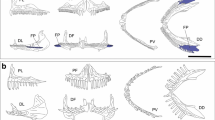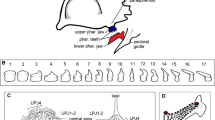Abstract
Oxudercine gobies show not only a full spectrum of habitat transition from water to land, but also varying feeding habits from herbivory to carnivory. In this study, we compared the anatomy of the feeding apparatus of five oxudercine gobies, Boleophthalmus boddarti (moderately terrestrial, herbivorous), Oxuderces nexipinnis (nearly aquatic, herbivorous), Scartelaos histophorus (moderately terrestrial, omnivorous), Periophthalmus chrysospilos (highly terrestrial, carnivorous), and Periophthalmodon schlosseri (highly terrestrial, carnivorous), collected from a mudflat in Vietnam. B. boddarti and O. nexipinnis are characterized by a horizontal disposition of the dentary teeth, more densely spaced gill rakers on the posterior row of the third arch and both rows of the fourth arch, and large, ventrally curved pharyngeal plates bearing numerous fine teeth. Ps. chrysospilos and Pn. schlosseri have oral jaw bones with jaw-levers producing a greater biting force, rudimentary gill rakers, and pharyngeal plates studded with robust canine teeth. On the underside of the ventral plates, prominent ridges occur, onto which strong muscles attach. The jaw adductors are larger in these carnivorous mudskippers. S. histophorus shows an anatomical architecture which may be considered intermediate between these herbivorous and carnivorous species. On the basis of currently accepted relationships of oxudercine genera, their feeding habits, and the morphology of the feeding apparatus, we hypothesize that the oxudercine gobies had been adapted to feeding microalgae in shallow water before expanding their niche onto land, and subsequently diverged to more specialized herbivorous (Boleophthalmus) and carnivorous groups (Periophthalmus and Periophthalmodon) feeding in higher intertidal habitats.












Similar content being viewed by others
References
Agorreta A, Rüber L (2012) A standardized reanalysis of molecular phylogenetic hypotheses of Gobioidei. Syst Biodivers 10:375–390
Agorreta A, Mauro DS, Schliewen U, Van Tassell JL, Kovačic M, Zardoya R, Rüber L (2013) Molecular phylogenetics of Gobioidei and phylogenetic placement of European gobies. Mol Phylogenet Evol 69:619–633
Bhikajee M, Green JM (2002) Behaviour and habitat of the Indian Ocean amphibious blenny, Alticus monochrus. Afr Zool 37:221–230
Chaudhuri A, Mukherjee S, Homechaudhuri S (2014) Food partitioning among carnivores within feeding guild structure of fishes inhabiting a mudflat ecosystem of Indian Sundarbans. Aquat Ecol 48:35–51
Clack JA (2012) Gaining ground: the origin and evolution of tetrapods, 2nd edn. Indiana University Press, Bloomington
Clayton DA (1993) Mudskippers. Oceanogr Mar Biol Annu Rev 31:507–577
Clayton DA (2017) Feeding behavior: a review. In: Jaafar Z, Murdy EO (eds) Fishes out of water: biology and ecology of mudskippers. CRC Press, Boca Raton, pp 237–275
Dingerkus G, Uhler LD (1977) Enzyme clearing of alcian blue stained whole small vertebrates for demonstration of cartilage. Stain Technol 52:229–232
Gidmark NJ, Pos K, Matheson B, Ponce E, Westneat MW (2019) Functional morphology and biomechanics of feeding in fishes. In: Bels V, Whishaw IQ (eds) Feeding in vertebrates: evolution, morphology, behavior, biomechanics. Springer, Cham, pp 297–332
González-Bergonzoni I, Meerhoff M, Davidson TA, Teixeira-de Mello F, Baattrup-Pedersen A, Jeppensen E (2012) Meta-analysis shows a consistent and strong latitudinal pattern in fish omnivory across ecosystems. Ecosystems 15:492–503
Gordon MS, Boëtius I, Evans DH, McCarthy R, Oglesby LC (1969) Aspects of the physiology of terrestrial life in amphibious fishes. I. The mudskipper, Periophthalmus sobrinus. J Exp Biol 50:141–149
Graham JB, Jones CB, Rubinoff I (1985) Behavioural, physiological, and ecological aspects of the amphibious life of the pearl blenny Entomacrodus nigricans Gill. J Exp Mar Biol Ecol 89:255–268
Heiss E, Aerts P, Van Wassenbergh S (2018) Aquatic–terrestrial transitions of feeding systems in vertebrates: a mechanical perspective. J Exp Biol 221:jeb154427
Hulsey CD, Roberts RJ, Lin ASP, Guldberg R, Streelman JT (2008) Convergence in a mechanically complex phenotype: detecting structural adaptations for crushing in cichlid fish. Evolution 62:1587–1599
Hundt PJ, Nakamura Y, Yamaoka K (2014) Diet of combtooth blennies (Blenniidae) in Kochi and Okinawa, Japan. Ichthyol Res 61:76–82
Ishimatsu A, Yoshida Y, Itoki N, Takeda T, Lee HJ, Graham JB (2007) Mudskippers brood their eggs in air but submerge them for hatching. J Exp Biol 210:3946–3954
Liem KF (1974) Evolutionary strategies and morphological innovations: cichlid pharyngeal jaws. Syst Zool 22:425–441
Liem KF (1990) Aquatic versus terrestrial feeding modes: possible impacts on the trophic ecology of vertebrates. Am Zool 30:209–221
Michel KB, Adriaens D, Aerts P, Dierick M, Van Wassenbergh S (2014) Functional anatomy and kinematics of the oral jaw system during terrestrial feeding in Periophthalmus barbarus. J Morph 275:1145–1160
Michel KB, Aerts P, Gibb AC, Van Wassenbergh S (2015a) Functional morphology and kinematics of terrestrial feeding in the largescale foureyes (Anableps anableps). J Exp Biol 218:2951–2960
Michel KB, Heiss E, Aerts P, Van Wassenbergh S (2015b) A fish that uses its hydrodynamic tongue to feed on land. Proc R Soc B 282:20150057
Mihalitsis M, Bellwood D (2019) Functional implications of dentition-based morphotypes in piscivorous fishes. R Soc Open Sci 6:190040
Mochizuki K, Fukui S (1983) Development and replacement of upper jaw teeth in gobiid fish, Sicyopterus japonicus. Jpn J Ichthyol 30:27–36
Morales A, Rosenlund K (1979) Fish bone measurements: an attempt to standardize the measuring of fish bones from archaeological sites. Zoological Museum, Copenhagen
Murdy EO (1989) A taxonomic revision and cladistic analysis of the oxudercine gobies (Gobiidae: Oxudercinae). Rec Aust Mus Suppl 11:1–93
Murdy EO, Jaafar Z (2017) Taxonomy and systematics review. In: Jaafar Z, Murdy EO (eds) Fishes out of water: biology and ecology of mudskippers. CRC Press, Boca Raton, pp 1–36
Nagatomo S, Machida Y, Endo H (2001) Growth-related changes in morphology and food habit of a blenny, Istiblennius edentulus, inhabiting rock pools at Shiranohana on Yokonami Peninsula, Kochi Prefecture. Bull Mar Sci Fish Kochi Univ 21:23–33
Nanami A (2016) Parrotfish grazing ability: interspecific differences in relation to jaw-lever mechanics and relative weight of adductor mandibulae on an Okinawan coral reef. https://doi.org/10.7717/peerj.2425
Nieder J (2001) Amphibious behaviour and feeding ecology of the four-eyed blenny (Dialommus fuscus, Labrisomidae) in the intertidal zone of the island of Santa Cruz (Galapagos, Ecuador). J Fish Biol 58:755–767
Norton SF, Brainerd EL (1993) Convergence in the feeding mechanics of ecomorphologically similar species in the centrarchidae and cichlidae. J Exp Biol 176:11–29
Polgar G (2017) Emergent patterns in spatio-temporal ecology. In: Jaafar Z, Murdy EO (eds) Fishes out of water: biology and ecology of mudskippers. CRC Press, Boca Raton, pp 301–326
Sahara N, Moriyama K, Iida M, Watanabe S (2013) Unique features of pedicellate attachment of the upper jaw teeth in the adult gobiid fish Sicyopterus japonicus (Teleostei, Gobiidiae): morphological and structural characteristics and development. J Morphol 274:512–524
Sakai H, Nakamura M (1979) Two new species of freshwater gobies (Gobiidae: Sicydiaphiinae) from Ishigaki Island, Japan. Jpn J Ichthyol 26:43–54
Sayer MDJ, Davenport J (1991) Amphibious fish: why do they leave water? Rev Fish Biol Fish 1:159–181
Schoch RR (2014) Amphibian evolution: the life of early land vertebrates. Wiley, West Sussex
Schwenk K, Rubega M (2005) Diversity of vertebrate feeding systems. In: Starck JM, Wang T (eds) Physiological and ecological adaptation to feeding in Vertebrates. Science Publishers, Enfield, pp 1–41
Shimizu N, Sakai Y, Hashimoto H, Gushima K (2006) Terrestrial reproduction by the air-breathing fish Andamia tetradactyla (Pisces; Blenniidae) on supralittoral reefs. J Zool 269:357–364
Sponder DL, Lauder GV (1981) Terrestrial feeding in the mudskipper Periophthalmus (Pisces: Teleostei): a cineradiographic analysis. J Zool Lond 193:517–530
Tran LX, Maekawa Y, Soyano K, Ishimatsu A (2020) Morphology of the feeding apparatus in the herbivorous mudskipper, Boleophthalmus pectinirostris (Linnaeus, 1758). Zoomorphology 139:231–243
Van Wassenbergh S (2013) Kinematics of terrestrial capture of prey by the eel-catfish Channallabes apus. Integr Comp Biol 53:258–268
Van Wassenbergh S, Bonte C, Michel KB (2017) Terrestrial capture of prey by the reedfish, a model species for stem tetrapods. Ecol Evol 7:3856–3860
Vandewalle P, Parmentier É, Chardon M (2000) The branchial basket in Teleost feeding. Cybium 24:319–342
Wainwright PC (2006) Functional morphology of the pharyngeal jaw apparatus. In: Shadwick RE, Lauder GV (eds) Fish physiology, fish biomechanics, vol 23. Academic Press, Amsterdam, pp 77–101
Wainwright PC, McGee MD, Longo SJ, Hernandez LP (2015) Origins, innovations, and diversification of suction feeding in vertebrates. Integr Comp Biol 55:134–145
Westneat MW (1994) Transmission of force and velocity in the feeding mechanisms of labrid fishes (Teleostei, Perciformes). Zoomorphology 114:103–118
Westneat MW (2003) A biomechanical model for analysis of muscle force, power output and lower jaw motion in fishes. J Theor Biol 223:269–281
Acknowledgements
We would like to acknowledge Dr. Gianluca Polgar (CNR IRSA Water Research Institute, Verbania, Italy) for his careful reading and insightful comments on the manuscript. We would like to thank Ms. Mizuri Murata (Institute for East China Sea Research, Nagasaki University) and Dr. Hieu Van Mai (College of Aquaculture and Fisheries, Can Tho University) for their help during the field study; Dr. Nguyen Van Cong, the Dean of the College of Environment and Natural Resources, Can Tho University and Dr. Tran Dac Dinh, the College of Aquaculture and Fisheries, Can Tho University for arranging our trips to Mo O; and a local fisherman for collecting samples.
Funding
Partly supported by Keidanren Nature Conservation Fund “Conservation and cleaning up of MoO mudflat, Mekong river-mouth”.
Author information
Authors and Affiliations
Contributions
LXT contributed to the morphological analysis. YM contributed to the micro-computed tomography scanning. LXT and AI contributed to writing the manuscript. All authors contributed to the final revision of the manuscript.
Corresponding author
Ethics declarations
Conflict of interest
The authors declare that they have no conflict of interest.
Ethical approval
All experimental procedures were conducted with the permission of the Animal Care and Use Committee of the Institute for East China Sea Research, Nagasaki University, Japan (Permit Number #16-01).
Informed consent
Additional informed consent was obtained from all individual participants for whom identifying information is included in this article.
Additional information
Publisher's Note
Springer Nature remains neutral with regard to jurisdictional claims in published maps and institutional affiliations.
Supplementary Information
Below is the link to the electronic supplementary material.

Fig. S1
PCA biplot of the two principal components (PC1, PC2) showing the multivariate morphometric ordination of the studied taxa (upper box). The morphological variables are represented by vectors; correlated variables have a similar orientation. Loadings of each variable along PC1 and PC2 are shown in the lower table. Symbols: den_length standardized tooth length on the dentary, den_replacement number of replacement teeth on the dentary, den_teeth number of teeth on the dentary, den_width standardized tooth width on the dentary, pre_length standardized tooth length on the premaxilla, pre_replacement number of replacement teeth on the premaxilla, pre_teeth number of teeth on the premaxilla, pre_width standardized tooth width on the premaxilla. Points 1–5 are the data of Boleophthalmus boddarti, 6–10 Oxuderces nexipinnis, 11–15 Scartelaos histophorus, 16–20 Periophthalmus chrysospilos, and 21–25 Periophthalmodon schlosseri. (JPG 615 KB)

Fig. S2
Comparison of the average space between gill rakers and the size of main food items (mean ± SD) ingested by Boleophthalmus boddarti (a), Oxuderces nexipinnis (b), and Scartelaos histophorus (c). The average space between gill rakers (horizontal orange line) was calculated for the posterior row of the third arch and both rows of the fourth arch in B. boddarti and O. nexipinnis, and for the posterior rows of the third and the fourth arches in S. histophorus. The longer-axis length (dark-gray bars) and the shorter-axis length (light-gray bars) were measured in 30 specimens of the five main food items found in the stomach contents of each fish species. D01–05 diatom items 1 to 5 recovered from each mudskipper species, A01–02 amphipod items 1 to 2 recovered from S. histophorus. (JPG 727 KB)

Fig. S3
Insertion of the retractor dorsalis (RD) to vertebrae in Boleophthalmus boddarti (a), Oxuderces nexipinnis (b), Scartelaos histophorus (c), Periophthalmus chrysospilos (d), and Periophthalmodon schlosseri (e). For O. nexipinnis, b1 shows the relative position of RD and vertebrae and b2 shows RD insertion on the neural spine of the fourth vertebra. Symbols: RD retractor dorsalis, V1-V4 neural spines of the first to fourth vertebrae. Dashed lines show joint between vertebrae (JPG 5764 KB)
Rights and permissions
About this article
Cite this article
Tran, L.X., Maekawa, Y., Soyano, K. et al. Morphological comparison of the feeding apparatus in herbivorous, omnivorous and carnivorous mudskippers (Gobiidae: Oxudercinae). Zoomorphology 140, 387–404 (2021). https://doi.org/10.1007/s00435-021-00530-8
Received:
Revised:
Accepted:
Published:
Issue Date:
DOI: https://doi.org/10.1007/s00435-021-00530-8




